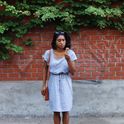I first encountered boba when I was visiting Singapore in the summer of 2002. I was wandering down Orchard Road with my aunt, in the heart of the city's main shopping district, noticing just how hot and sticky the summer heat was. Eventually fed up with my complaints of thirst, she paused for a moment, told me to hang tight, and disappeared for a few minutes.
My aunt returned with two sealed cups of a pastel-colored, creamy-looking liquid—one lavender, one mint-green—and brandishing two thick, plastic straws that looked like they were made for giants. As she came closer, I noticed there was a dark, syrupy mass pooled at the bottom of the drink.
"What is that?" I asked.
"It's boba," she explained. "Milk tea with tapioca bubbles. Do you want taro, or honeydew?"
"Taro, please." From that first sip, a long and wonderful relationship began.
Boba, aka pearl milk tea, bubble tea, or tapioca milk tea, is a popular drink that originated in Taiwan in the 1980s. It consists of three elements that were already popular in Taiwan at the time—sweet milk tea, shaved ice, and tapioca pearls in sweet pudding—and as the story goes, one food-stall owner cleverly thought to combine them, to enormous success. What resulted was an intensely refreshing, massively popular drink.
The drink's name, "boba," (a slang word in Chinese meaning "female breasts") refers to the sweet, chewy pearls themselves, which are made of refined tapioca starch that comes from the root of the cassava plant. To make the bubbles, tapioca starch is combined with brown sugar, partially cooked, and formed into a dark-colored, very sticky dough.
The dough then gets rolled out into 1/4-inch (or so) spheres and fully dried before being sold commercially. To revive these dried balls and ready them for boba tea, they are braised in a water–sugar syrup until soft and tender, and then left to cool in their syrup.
The pearls are added to a tall glass, and on top of them goes a drink of some sort. Typically, this is sweetened black tea with milk (or, more commonly these days, shelf-stable non-dairy creamer) that's also flavored with syrup—anything from taro to chocolate to honeydew to brown sugar.
However, clear, fruity teas, made with green tea, jasmine tea, or even rooibos bases, and flavored with fruit syrup of all sorts, have grown to become more popular drinks that accompany boba. So has sweetened coffee with milk, and frozen, milkshake-like slushies of all sorts.
After the bubbles and the tea have come together, the drink is rounded out with a whole lot of ice, to keep it especially cool and refreshing (though—hot tip—you can also drink boba milk tea hot, a cold-weather favorite for me).
Luckily for all of us, boba made its way through Southeast Asia from Taiwan, and has now become extremely popular in the U.S., the U.K., and beyond.
There are now all kinds of chain tea shops that serve boba worldwide, such as Lollicup Coffee & Tea, which has locations in several U.S. and Chinese cities, and is soon expanding to Europe and the Middle East. Tapioca Express is another example in this vein.
Others, like New York's Kung Fu Tea, San Francisco's Boba Guys, and Southern California's (originally, Taipei's) 85°C Bakery & Cafe are more regional, but are certainly among my personal favorites.
And many of these places also serve up all kinds of goodies inside their signature milk tea, in traditional boba's place: whole sweet red beans in syrup; and cubed-up grass jelly, almond jelly, or mango jelly; sweet egg pudding; teeny-tiny mini-boba; and even "bursting" boba filled with fruit or tea gel.
No matter where you go, though, you'll likely find your boba in a signature ribbed plastic cup and sealed tightly with a piece of plastic (this is done in a special sealing machine); before you start drinking, you'll cathartically "pierce" the plastic with a pointy-ended, super-thick (usually 1/2-inch) straw to access all the goodness inside your cup.
To make boba at home, you can buy dried tapioca pearls at the store or online, and cook them to your desired tenderness in brown-sugar syrup. (You can make the pearls themselves at home, too, which is a bit of an undertaking, but totally worth it for the chewy, tender perfection that results.) Then, just brew some milk tea with the flavor and sweetness of your choosing, and sip (and chew!) to your heart's content.
Why make boba at home, you ask, when there are so many amazing milk tea purveyors scattered around the world? Well, for one, you can cook the pearls to a level that's as tender or firm as you like; you can control the sweetness and flavor profile of the tea, using natural flavorings and fruits if you prefer; and, most importantly, you can have as many helpings as you wish.
Below, a few ideas for your next (or first!) batch of homemade boba tea.
Where's your favorite place to get boba? And what's your go-to flavor? Let us know in the comments!








Join The Conversation